Chapter 4 : Metaphysics: Post Modernism and Multiple Realities
There is a large object or entity in the American Museum of Natural History in New York City. It is very large indeed. It has been there for some time and a very large and very expensive new building has been built around it rather than attempt to move it again. It was brought to the museum from the northwest of the United States. It has been labeled as a meteorite, the Williamette Meteorite, from the Williamette Valley of Oregon. It weighs 15 tons and scientists claim that it fell to earth about 10,000 years ago. There is a group of native people from a tribe (Clackamas) in the state of Oregon. They are part of the Confederated Tribes of the Grand Ronde of Oregon. The native peoples claim that it is not a rock but a messenger, the Sky Person, Tomanowos, from the sky god who came to earth as a messenger and guide and who speaks to their people. The want the messenger returned to their people. The museum acquired it from a woman, Mrs. William Dodge, who donated it to the museum. She bought it from a iron mining company that had it on land owned by the company. Both parties went to court. A settlement was reached out of court. The original peoples will get to visit the rock-messenger each year and perform rituals there in the museum. Now is the object an inanimate rock or an animated messenger? Is it both or neither? What is the reality? For the postmodernists it is both at once. They would allow that it really is a messenger and it really is a rock at the same time, because there is no one objective reality or truth.
Most, if not all of you, will probably refer to the
entity in the American Museum of Natural History as a meteorite. This
might indicate that because you were brought up in a culture that accepts
scientific method and materialism that is how you look at it. You think of
it as a meteorite that some people think contains a spirit. But this may
not be correct. The original peoples see it as a spirit NOT a meteorite.
They think of it as a spirit that some people choose to think of as a
rock. But to them it is a spirit and NOT a rock. It is alive and NOT
dead.
Now which is it?
a. rock/meteorite and dead
b. spirit and alive
You can not choose to think of it as a rock that people think of a as a
spirit because when you do all you are claiming is a.) that it is a rock
that some people may perceive differently. Is that what you think or is it
b.) a spirit that some people choose to think of or perceive as a rock?
Or is it both or neither? Which is correct and why?
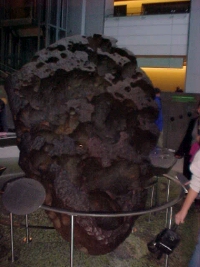
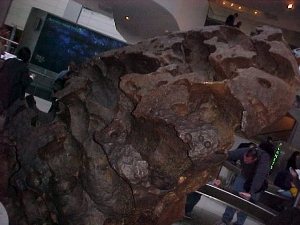
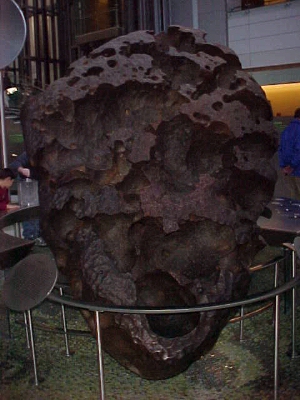
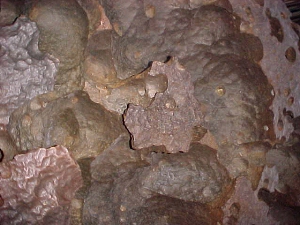
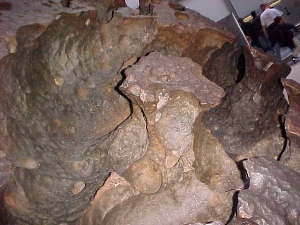
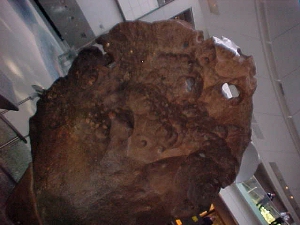
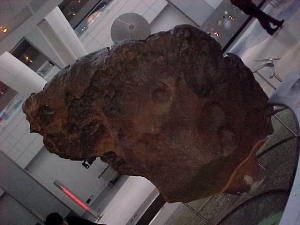
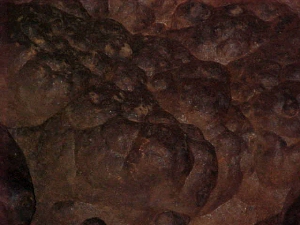
February 14, 2002 NEW YORK TIMES
Uproar Over a Sliced, and Revered, Meteorite
By KENNETH CHANG
When the American Museum of Natural History opened its gleaming new planetarium two years ago, it gave its highest place of honor to the Willamette meteorite, the pitted, 15 1/2-ton boulder that fell to Earth more than 10 millennia ago.
But unknown to most of its admirers — or until recently to the Oregon tribe that considers it sacred — the meteorite has a flat spot at the top, created by museum curators in 1998 when they cut off a 28-pound chunk and traded it to a private collector for half an ounce of Mars.
On Sunday, the collector, Darryl Pitt of New York City, sold a six-inch, 3.4-ounce slice off that chunk for $11,000 at an auction.
A second, smaller piece of a meteorite Mr. Pitt obtained in a trade with the Natural History Museum in London a couple of months ago sold for $3,300.
"This is not anything that is unusual," said Mr. Pitt, whose Macovich Collection is the largest private collection of meteorites in the world.
But the auction dismayed descendants of the Clackamas Indians of Oregon who regard the meteorite as a spiritual union of earth, sky and water.
"Would someone want to auction off a crucifix, one of the holy statues out of the Catholic Church or something like that?" asked Kathryn Harrison, former chairwoman of the Confederated Tribes of Grand Ronde, which includes the Clackamas.
The Oregonian, the state's largest newspaper, took up the cause, accusing the American museum in an editorial on Saturday of showing "disgraceful stewardship" of the meteorite. "If we had our way, it would be heading back on the next westbound freight train," the newspaper said.
Dr. David Wheeler, a chiropractic physician in West Linn, Ore., who bought the smaller thumbnail-size piece that weighs a third of an ounce, said he wanted to discuss with the tribal members how he might share his new purchase with them.
"I did it, because I wanted to bring a small part of the meteor back to Oregon," Dr. Wheeler said. "I may end up donating it to them."
Matt Morgan, a meteorite trader in Colorado who runs the Internet site Mile High Meteorites, bought the larger piece "because it's a historic American meteorite and one which I don't have," he said. "It's one of the things you always read about in the books."
Mr. Morgan said he and two other investors would cut that piece into six or seven smaller pieces, keeping some for themselves and selling the others. "We'd like to recoup some of the investment we made," he said.
The Willamette meteorite, the largest meteorite ever found in the United States, is believed to have originally landed in Canada, and then was pushed by glaciers to Oregon's Willamette Valley thousands of years ago. The American Museum of Natural History bought it in 1906.
Two years ago, after the opening of the museum's Rose Center, the tribes demanded that the meteorite be returned.
The tribes and the museum settled their dispute with an agreement in which the meteorite remains in New York and tribal members can conduct a private ceremony once a year at the center.
But dozens of pieces of the Willamette meteorite were removed over the years and scattered to institutions around the world.
Meteorite collectors trade pieces of space rock the way boys once traded baseball cards: a slice of Mars for a chip of carbonaceous chondrite, a Moon rock for a new meteorite find from the Sahara.
Unlike curators of art or fossils, where great value is placed on the integrity of objects, meteorite curators at major museums participate in the trading game, giving samples of their collection to private collectors in exchange for newly discovered rocks.
"In meteoritics, it's long been a tradition to trade pieces of specimens," said Dr. Michael J. Novacek, provost of science at the American Museum of Natural History. Scientists routinely cut meteorites apart for scientific study exchange and send pieces back and forth for different laboratories to analyze.
Trading pieces of the museum's meteorites with private collectors allows the museum to acquire new, rare meteorites, Dr. Novacek said. "It ultimately had a scientific purpose," he said.
In exchange for the 28-pound piece of the Willamette meteorite, Mr. Pitt gave a part of the Governador Valadares meteorite, which landed in Brazil in 1958, one of a few known to have come from Mars.
When Chips for Bartering Fall From the Sky
By KENNETH CHANG
![]() ant
a piece of a historic meteorite from the Smithsonian collection or maybe
the Natural History Museum in London?
ant
a piece of a historic meteorite from the Smithsonian collection or maybe
the Natural History Museum in London?
Offer a blank check and the answer will be, sorry, it is not for sale.
But there is a good chance that the curators at those and other natural history museums will give it to you — if you can trade another extraterrestrial rock they want.
Rare meteorites act as their own currency, giving private collectors access to collections at the most prestigious museums.
That is how two pieces of the Willamette Meteorite — the prized, 15 1/2-ton centerpiece of American Museum of Natural History's planetarium — wound up at auction this month, to the dismay of Oregon Indians who regard it as sacred and to the concern of some museum association officials.
In recent years, an avid collector's market has pushed prices for precious meteorites to thousands of dollars an ounce, often too expensive for universities and museums. What academic institutions do have are historic meteorites that collectors want a piece of. Hence, they trade.
"We're forced into doing that kind of thing," said Dr. Rhian H. Jones, curator at the University of New Mexico's Institute of Meteoritics. "The private dealers, they're not donating the material to research. If we want to do the research, we have to get the material into the collection. It doesn't harm our collection significantly to trade a small piece of meteorite that we have a large amount of it for something that has scientific value."
Once in private hands, a museum meteorite is typically cut into smaller and smaller pieces and sold and resold at sometimes considerable profit. Or the collector makes more trades to gain yet more rocks.
Collectors say the high values have spurred more people to hunt for meteorites, and that aids the scientists.
"If it were not for the new meteorite bonanza of the 90's, the research community would never have had so many new rare and exciting specimens made available to them," said Michael I. Casper, a meteorite dealer and collector in Ithaca, N.Y.
But for museum visitors, sometimes there is slightly less to see. At the top of the Willamette Meteorite — the largest ever found in the United States — is a smooth, polished surface about a foot wide where the museum cut off a 28-pound chunk about four years ago. Small fragments from that chunk are now for sale at mhmeteorites.com. The Web site informs the viewer: "Available exclusively at Mile High Meteorites."
The museum had traded the 28- pound chunk to a private collector, Darryl Pitt of New York City, for a small piece of a meteorite from Mars, and Mr. Pitt, in turn, cut a 3.4- ounce slice off his chunk, which he auctioned off on Feb. 10 for $11,000.
The buyer, Matt Morgan, owner of Mile High Meteorites, will cut it into six or seven pieces, keeping some, selling others. A second, smaller piece of the meteorite, which Mr. Pitt had obtained in a trade with the Natural History Museum in London, sold for $3,300.
The auctions have upset descendants of the Clackamas Indians in Oregon, where the meteorite was found. They regard it as a spiritual union of earth, sky and water. The trade between Mr. Pitt and the museum occurred a couple of years before the claim; the museum says it will not cut any more pieces.
The buyer of the smaller piece, Dr. David Wheeler, a chiropractor in West Linn, Ore., has said he may donate it to the Confederated Tribes of Grande Ronde, which includes the Clackamas. Mr. Morgan said Friday that he and his two fellow investors would also give a small piece to the tribes.
But even had there been no cultural considerations, some find it troubling that a piece of a meteorite was cut off not to be studied, but to fill the desire of a collector.
"It's almost defacing," Nancy Heller of New York City, a visitor to the planetarium last week, said of the Willamette Meteorite. "I can't imagine anyone deliberately wanting to damage a work of art. This is not exactly a work of art, but it is a museum."
Dr. Geoffrey Lewis, chairman of the ethics committee of the International Council of Museums, said that he was troubled by some of what he had heard about the meteorite trades and that his committee would review the practice when it met this summer in Paris. "Clearly, there are many issues there, which should be examined," he said.
He said he could not comment on the Willamette Meteorite trades because he did not know the details. But he cited several sections in the council's Code of Professional Ethics, which state that there should be a "strong presumption" against getting rid of specimens, that museum professionals should not participate in the buying or selling of objects for profit, even indirectly, and that collections should not be treated as "realizable assets."
Dr. Michael J. Novacek, the provost of science at the American Museum of Natural History, said the museum is not a member of the international council and that the museum's practices were entirely in line with the code of ethics established by the American Association of Museums, which states that sales or trades should occur "solely for the advancement of the museum's mission."
The trade with Mr. Pitt brought the museum a sample of a very rare Martian meteorite, more important scientifically than the fairly common iron of the Willamette Meteorite.
"Our motive is to raise the scientific value of the collection," Dr. Novacek said. "We don't view ourselves as out of compliance with any ethics."
Still, when meteorite collectors view museum collections, they sometimes seem more like shoppers than visitors.
Mr. Morgan of Mile High Meteorites said he regularly traded with museums at a couple of universities. When he gets something new, he sends e-mail messages to the curators: "I say, are you guys interested in any of this?"
He keeps catalogs of the museums' collections, so if they're interested, he can suggest what he would like in return.

Introduction to Philosophy by Philip A. Pecorino is licensed under a Creative Commons Attribution-NonCommercial-NoDerivs 3.0 Unported License.